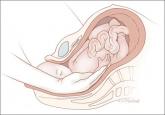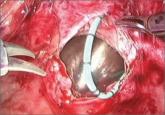From the Editor

Tackle the challenging shoulder dystocia emergency by practicing delivery of the posterior arm
Successful delivery of the posterior arm may require finding and firmly grasping the fetal hand, wrist, and/or distal forearm

Notable judgments and settlements
IN THIS ARTICLE
-Woman dies from cervical cancer: $2.33M
-Was it HELLP syndrome?
-Vesicovaginal fistula after hysterectomy
-Did she really need that hysterectomy?
-Erb’s palsy: $1.7M net award
-Was nonreassuring fetal heart rate ignored?
-Patient says wrong ovary was removed
-Second pregnancy ends in injury after shoulder dystocia
Negligence during cord blood sampling? Child has CP
A woman’s first child was treated for neonatal alloimmune thrombocytopenia (NAIT) after birth. When prenatal testing identified NAIT in her second child, the mother received twice-weekly immunoglobulin injections to increase the fetus’ platelet count.
At 33 weeks’ gestation, percutaneous umbilical blood sampling (PUBS) was undertaken by a maternal-fetal medicine (MFM) specialist to check the baby’s platelet count and inject additional platelets. During the procedure, the mother’s blood pressure dropped from 122/80 to 80/40 mm Hg. The fetal heart rate dropped from 120–130 bpm to 65 bpm. An emergency cesarean delivery was performed.
At birth, the baby had seizures and respiratory distress secondary to perinatal asphyxia. She has severe spastic quadriplegic cerebral palsy. At age 9 years, she has been hospitalized for multiple complications, underwent tendon-release procedures on both legs, and receives occupational and physical therapy. She cannot speak, needs a feeding tube, is wheelchair bound, and requires 24-hour nursing care.
PARENTS’ CLAIM The MFM was not adequately trained to perform PUBS and did not use continuous ultrasound guidance during the procedure. She was negligent in attempting to insert the needle into the umbilical cord multiple times. She failed to recognize fetal distress. The anesthesiologist only told the MFM that the patient was hypotensive, not that the patient’s blood pressure never returned to baseline.
defendants’ DEFENSE The mother was part of a NAIT study, and the procedure was properly performed under the guidelines of that study. A sonographer constantly monitored the fetal heart rate. The anesthesiologist claimed that proper actions were taken in response to low blood pressure; there was no requirement to communicate more information to the MFM. The child’s hypoxia was due to placental abruption. The estimated cost of the life-care plan for the child is $5 to $10 million.
VERDICT A $15 million Indiana verdict was returned against the medical center that employed the anesthesiologist, but was reduced to $1,250,000 by the state cap. A defense verdict was returned for the MFM.
Woman dies from cervical cancer: $2.33M
When a woman had an abnormal Pap smear in 2001, her gynecologist did not order a repeat test, but told the patient to return in 3 months. The patient did not see the gynecologist again until 2007. At that time, her Pap smear was normal, but she was experiencing symptoms. The gynecologist did not order further testing.
In 2009, the patient was found to have advanced cervical cancer. She died 2 years later at age 48.
ESTATE’S CLAIM The second Pap smear was incorrectly interpreted. Further testing should have been ordered in 2001 and 2007.
DEFENDANTS’ DEFENSE The laboratory and patient’s estate settled for a confidential amount before the trial commenced. The gynecologist denied negligence. He claimed the patient was at fault for not returning to see him, as recommended.
VERDICT A New Jersey jury found the gynecologist 40% at fault, the laboratory 50% at fault, and the patient 10% at fault. A gross verdict of $2.33 million was returned.
Was it HELLP syndrome?
By her prenatal visit at 33 weeks’ gestation, a mother had gained 59 lb during her pregnancy. Three days later, she went to the emergency department (ED). The fetus had died.
PARENT’S CLAIM The ObGyn failed to intervene when the mother was gaining excessive weight. The mother had HELLP syndrome (hemolysis, elevated liver enzymes, and low platelet count); timely diagnosis could have avoided fetal demise.
DEFENDANTS’ DEFENSE Fetal demise could not have been diagnosed or prevented. The cause of the mother’s illness was never fully identified.
VERDICT A Tennessee defense verdict was returned.
Vesicovaginal fistula after hysterectomy
A woman underwent a hysterectomy performed by her ObGyn. A week later, during a postoperative visit, the ObGyn detected a bladder injury and related vesicovaginal fistula. He attempted a repair, but it failed. Eventually, successful repair surgery was performed by a urologist.
PATIENT’S CLAIM The ObGyn only should have used sharp dissection during the hysterectomy, as opposed to a combination of sharp and blunt dissection, due to dense adhesions that had developed after earlier abdominal surgery. Because the ObGyn had never repaired a vesicovaginal fistula before, he should have requested the assistance of a urologist or urogynecologist. A peritoneal flap should have been used during the initial repair.
PHYSICIAN’S DEFENSE Referral to a urologist or urogynecologist had been offered to the patient, but was refused (no record of this was found in the patient’s file). There was no negligence in the attempted repair.
VERDICT A $387,000 Virginia verdict was returned.
Did she really need that hysterectomy?
A 31-year-old woman went to the ED with sudden, severe abdominal pain. The radiologist noted that the patient’s appendix could not be visualized on computed tomography (CT) because it was behind the cecum. A general surgeon interpreted the report as ruling out appendicitis, made a diagnosis of pelvic inflammatory disease, and requested a gynecologic consult. An ObGyn sent his nurse practitioner to see the patient in the ED. The patient was discharged and instructed to follow up with the ObGyn.
When the patient’s condition worsened 2 days later, she returned to the ED. The ObGyn performed laparoscopic exploratory surgery. When he could not find the appendix, he called the general surgeon. The surgeon was in his car, and told the ObGyn that it was unnecessary to visualize the appendix; the ObGyn could complete the surgery. The patient was again discharged without a firm diagnosis. She was readmitted to the hospital several hours after discharge and treated for sepsis.
She was in and out of the hospital several times during the next 7 weeks until the ObGyn told her that the only way to cure her pain was to perform a partial hysterectomy. He scheduled a concurrent prophylactic appendectomy by the general surgeon. At surgery, the surgeon found and removed a burst appendix. The ObGyn then performed a hysterectomy, although he had been present during the appendectomy.
PATIENT’S CLAIM Any general surgeon could have come into the operating room during exploratory surgery to assist in ruling out appendicitis; there were other general surgeons available at the hospital. The ObGyn was negligent in performing the hysterectomy after the surgeon had performed the appendectomy.
PHYSICIAN’S DEFENSE The general surgeon died before the case could be deposed. The ObGyn admitted that the removal of the burst appendix resolved the patient’s medical problems; her uterus had not been damaged by sepsis.
VERDICT A $350,000 Michigan settlement was reached.
Erb’s palsy: $1.7M net award
At 38 weeks’ gestation, a mother went to the local ED reporting shortness of breath. She was transferred to a university medical center where a chest x-ray revealed what was thought to be pneumonia or a pulmonary embolism. The decision was made to induce labor. During vaginal delivery, shoulder dystocia was encountered.
The 3-year-old child has Erb’s palsy and, despite treatment and therapy, does not have full use of her left arm and shoulder.
PARENTS’ CLAIM Maneuvers undertaken to relieve shoulder dystocia were not properly performed, injuring the baby. A cesarean delivery should have been performed because of the mother’s condition.
DEFENDANTS’ DEFENSE Proper maneuvers were used. There was no medical necessity for emergency cesarean delivery.
VERDICT A $3 million Maryland verdict was returned. After state caps and recalculation of a lost-wages claim from the mother due to jury error, the net award was $1.7 million.
Was nonreassuring fetal heart rate ignored?
In her third trimester, a 20-year-old woman was admitted to the hospital for observation, which included fetal heart-rate monitoring.
After 2 days, the patient began to bleed vaginally, and the nurses called the ObGyn. When he came to the hospital, he performed emergency cesarean delivery. The fetus was stillborn.
PATIENT’S CLAIM The nurses failed to inform the ObGyn when nonreassuring fetal heart-rate monitoring results were first evident. The ObGyn did not come to the hospital immediately after being told about the vaginal bleeding. The surgical team was not ready when it was time for the cesarean delivery.
DEFENDANTS’ DEFENSE The case was tried against the hospital that employed the nurses and ObGyn. The hospital claimed that fetal demise was caused by a sudden placental abruption. The nurses’ actions were appropriate. The hospital faulted the ObGyn for not coming to the hospital when summoned by the nurses.
VERDICT A $100,000 Louisiana verdict was returned. The jury found the ObGyn 99% at fault and the hospital 1% at fault. The patient was awarded $100,000 from the Patient’s Compensation Fund; the hospital paid $1,000.
Patient says wrong ovary was removed
A woman saw her ObGyn (Dr. A) because of lower abdominal pain. Dr. A performed laparoscopic right salpingo-oophorectomy.
A tumor on the left ovary was found 5 months later, and a second operation was performed by another ObGyn (Dr. B) with Dr. A’s assistance. During this surgery, the patient’s sigmoid colon was injured; a fistula developed and a third operation was required to repair the colon.
PATIENT’S CLAIM The initial plan was to remove the left ovary. When Dr. Aremoved the right ovary instead of the left, the patient experienced sudden onset of menopause; the left ovary was nonfunctional. Dr. B was negligent in injuring the sigmoid colon.
PHYSICIANS’ DEFENSE Dr. B was released from the case because colon injury is a known complication of the procedure. Dr. A claimed that the radiologic film of the mass was misleading, and that the ovary he removed was diseased.
VERDICT A Virginia defense verdict was returned.

Successful delivery of the posterior arm may require finding and firmly grasping the fetal hand, wrist, and/or distal forearm

Although traditionally rare, this is a challenging repair that you may begin to encounter more often. Here, steps to an expert approach to...
By arming yourself with knowledge of the most common complications—and their causes—and employing well-chosen surgical strategies, you can lower...

How transvaginal ultrasound can expedite the diagnosis
